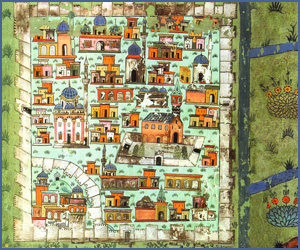Impact from Within, and Impact on the West
The point of departure
of Islamic construction and design, obviously, is the mosque,
and in a chronological order the first such mosque: the
Prophet’s (PBUH) Mosque.
Artz in his thorough and lengthy description of this
edifice and those that followed captures the central element of
faith as the fundamental determinant of both design and
decoration.[1]
The Prophet’s mosque was
a small dwelling, built in 622 at Madinah
under his direction, but to
evolve, and serve as the model for most of the later mosques.
The whole was a square enclosure, entirely surrounded by walls
of brick and stone. One side of the enclosure was roofed with
palm branches covered with mud and supported by palm trunks. The
next mosque, built in today’s
The mosques (like the palaces), although severe
externally, were lavishly decorated within with glazed tiles,
low flat carvings known as arabesques, rich marble, and carpets;
the mosques also had stained-glass windows. However, human and
animal forms were strictly forbidden by the Qur’an. Islam also
opposed luxury. "He who drinks from gold and silver vessels
drinks the fire of Hell," says a Hadith
(Prophetic Saying/Muslim
tradition.) In order to avoid the forbidden, the Muslims, Artz
adds, made vessels and tiles of earthenware and covered them
with gold lustre; they inlaid steel, brass, copper, and bronze
objects with fine bands of gold and silver; and they often
carved their complicated arabesques in plaster, even in a place
like the mihrab. The typical Islamic decoration was based on
interlacing lines and geometric designs, and used much colour.
Coloured tile and carved and painted arabesque are in fact the
common decorative means of Islam. These were combined with the
use, in ceilings, of stalactite forms and types of complicated
coffering. The designs of both tiles and arabesques showed great
taste, ingenuity, and inventiveness. Muslims Arabic calligraphy,
‘the most beautiful that man has devised, as a common decorative
motif,’ as Artz holds, uses the text of the Qur’an.[2]
Durant explains the architectural revolution, which
transformed the old courtyard of the mosque into the madrasa or
collegiate mosque throughout Eastern Islam. As mosques increased
in number, it was no longer necessary to design them with a
large central court to hold a numerous congregation; and the
rising demand for schools required new educational facilities.[3]
From the mosque proper-now almost always crowned with a
dominating dome-four wings or transepts spread, each with its
own minarets, a richly decorated portal, and a spacious lecture
hall. Normally each of the four ‘orthodox’ schools of Islamic
theology and law had its own wing.[4] This revolution in
design was continued by the Mamluks
in mosques and tombs firmly built
in stone, guarded with massive doors of damascened bronze, lit
by windows of stained glass, and brilliant with mosaics,
carvings in coloured stucco, and such enduring tiles ‘as only
Islam knew how to make.’[5]
The mosque of Cordova is certainly one of the most
written about for its aesthetics as much as its impact on
subsequent buildings.[6] In
its earliest form it was a courtyard mosque of rectangular plan,
with a sanctuary of eleven aisles akin to that of the original
al-Aqsa mosque at
The intensity of light due to the great number of
lamps used is no exaggeration, or unique. Artz speaks of the
Mosque
of Damascus
being lit by thousands of hanging
lamps of metal and of enamelled glass.[17]
The Muslim impact on subsequent Western construction
techniques is a vast subject only touched upon succinctly here.
The Cordova mosque, just referred to, had a great impact on the
architecture of the
Muslim masons were
widely used in Christian parts, especially following Christian
military victories and conquest of former Islamic territory.
An early instance is the
capture of Barbastro in the north-east of
Contacts between Normans and Muslims also go far
towards explaining the ambitious architectural programme which
became manifest in northern
[1]
F.B. Artz: The Mind; op cit; pp. 172-4.
[2]
Ibid.
[3]
W. Durant: The Age of Faith; op cit; pp. 317.
[4] Ibid.
[5] Ibid.
[6] See, for instance, E. Lambert: Histoire de la Grande Mosquee de Cordoue,
Annales de l’Institut d’Etudes Orientales; 2; 1963;
A.A. Salem: Cronologia de la mezquita mayor de Cordoba
; Al-Andalus
; 19 (1954), etc.
[7]
D. Talbot Rice: Islamic Art; op cit; p. 77.
[8]
Al-Maqqari: Nafh Al-Tibb; op cit; vol 2; pp. 60
ff.
[9]
D. Talbot Rice: Islamic Art; op cit; p. 77.
[10]
Al-Maqqari: Nafh al-Tibb; op cit; pp. 84 ff; in
A. Chejne: Muslim Spain, op cit; p. 365.
[11]
Ibid.
[12]
D. Talbot Rice: Islamic Art; op cit; p. 77.
[13]
Ibid; p. 79.
[14]
Al-Maqqari: Nafh al-Tibb; op cit; pp. 67; 84; 89;
in A. Chejne: Muslim Spain; op cit; p. 365
[15]
S.P. Scott: History; op cit; vol 1; p. 663.
[16]
Ibid.
[17]
F. Artz: The Mind; op cit; p.148.
[18]
Gomez
[19]
F. Artz: The Mind; op cit; p. 148.
[20]
J. Harvey: ‘The Origins of Gothic Architecture
,' Antiquaries Journal
48, 1968, pp 91-4. In L. Cochrane: Adelard of
[21]
M. S. Briggs: Architecture
, in The Legacy of
Islam, edited by T. Arnold and A. Guillaume (Oxford
University Press, first edition, 1931), pp 155-79.
[22]
Ibid; pp 167-8.
[23]
Ibid.
[24]
Ibid; p. 179.
[25]
E. Lambert: L’Art Hispano Mauresque et l’Art Romant;
Hesperis; 17; pp. 29-43; at pp. 38-9.
[26]
Ibid; p. 43.
[27]
Ibid; p. 43.
[28]
J. Harvey: The Development of Architecture
, op cit; p. 86.
[29]
Ibid.
[30]
Ibid.
[31]
S.P. Scott: History; op cit; vol 2;
p. 222.
[32]
Ibid. |
